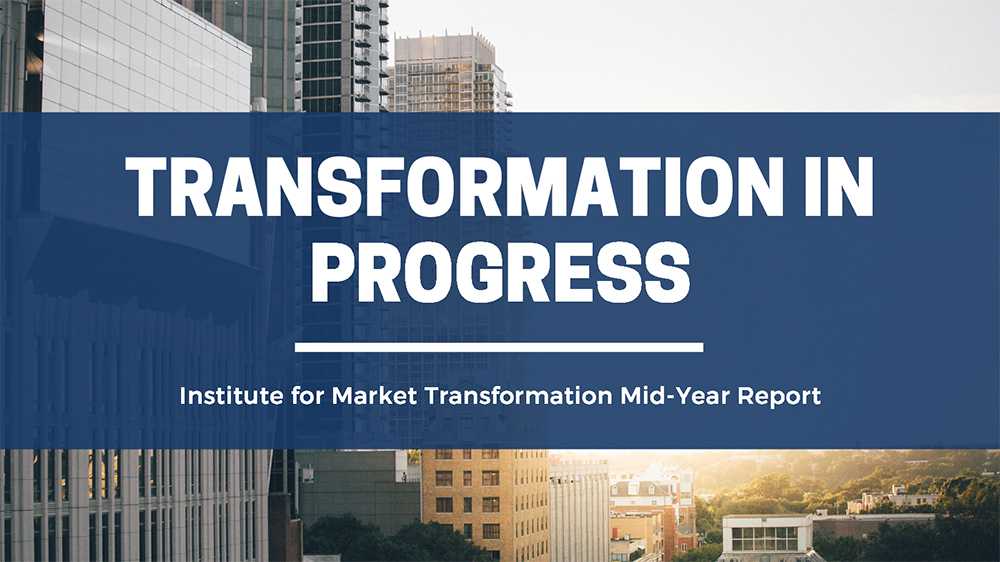For more than 20 years, IMT has worked toward a future in which all buildings are highly efficient. Our progress is now captured in semi-annual reports. Our work would not be possible without the on-going support of passionate funders and partners. If you are interested in connecting with us on this end, please contact Andrew Burr at andrew@imt.org or 202-525-2883, x308.
Updated July 2019

Catalyzing Action on an Unprecedented Opportunity
Now is the time to invest in buildings at a scale never before seen. Increasing the performance of U.S. buildings offers an unprecedented opportunity to:
The Institute for Market Transformation guides governments, companies, and organizations in making these possibilities a reality. We accelerate the pace and depth of change by focusing on the intersection of market dynamics and public policy to catalyze widespread and lasting demand for high-performing buildings.
IMT’s focus on market transformation continually increases the benefits of efficiency for all. Our work has never been more important. It also would not be possible without the support of our funders and partners who share our vision and goals. This mid-year report highlights some of the progress we are making together to improve buildings—and, as a result, lives—across the country.
How Does IMT Drive Market Transformation?
IMT aims to ignite widespread, lasting market demand for efficient buildings. How do we make this happen?
Want to learn more about IMT? Start here.
How Are We Driving Transformation Together This Year?

Across the globe, cities and companies are making bold, ambitious climate commitments. With building energy use accounting for a high percentage of carbon emissions in most U.S. cities, these commitments cannot become reality without substantially improving the way all buildings use energy.
Through our work leading building efficiency efforts in large-scale initiatives such as the City Energy Project and the American Cities Climate Challenge, as well as through our focused technical support of critical peer networks such as the Urban Sustainability Directors Network, IMT is turning ambition into action.
For example, over the past six years, the City Energy Project worked with 20 local governments across the U.S. to activate their local markets and unleash the many benefits of more efficient buildings. Across these cities, CEP helped spark efficiency efforts touching more than 10% of America’s large buildings. By the year 2030, the 20 CEP cities and their actions through the program have the potential to save more than $1.5 billion annually in energy bills and reduce carbon pollution by more than 9.6 million metric tons. Now, the City Energy Project Resource Collection, released this past February, is available to help other cities become more efficient and, in turn, more prosperous and competitive, healthy, and resilient.

| IMT anchors its work in community priorities in order to implement solutions that work for everyone. One critical pathway to success is activating essential partnerships between a city’s public and private realms. Take IMT’s Small Business Energy Initiative, which is working with seven chambers of commerce across five states. Built upon a foundational partnership with Northeast Ohio’s Greater Cleveland Partnership/Council of Smaller Enterprises, the Initiative is giving chambers of commerce the tools, knowledge, and guidance to help their small business members become stronger by investing strategically in energy efficiency. To date, the program has uncovered more than $8.7 million in energy savings and conducted more than 553 energy audits to drive building upgrades. This past May, we convened some of the participating small business energy changemakers to discuss why every chamber of commerce and small business organization should get involved in energy efficiency. A sample is below and I invite you to check out the full video series online. |
Consider also IMT’s popular Green Lease Leaders program, which celebrates productive landlord-tenant partnerships. Launched in 2014, Green Lease Leaders is now the premier industry recognition program for forward-thinking real estate companies who successfully use their leases to spur collective action on energy efficiency in buildings. To date, Green Lease Leaders represent more than 2 billion square feet of building space, a clear indication that green leasing continues to grow as a best practice across markets and building types. Do you know one of this year’s most recent leaders, announced last month at the Building Owners and Managers Association national conference?

Deep, rapid energy reductions across a wide swath of buildings are possible today. IMT focuses on creative new approaches that address the barriers that have traditionally stymied market transformation. One example is the growing number of advanced building performance standards emerging across the U.S.
This past December, the District of Columbia passed the Clean Energy DC Omnibus Act. Based on the District’s Clean Energy DC plan, which IMT helped write, it made the District the first U.S. jurisdiction to require a broad swath of existing buildings to improve their whole-building energy performance. To do this, the bill introduces a novel policy mechanism for which IMT provided critical guidance: the building energy performance standard (BEPS). Learn more in my blog on BEPS and the legislation here.
IMT is also pleased that the team we lead was recently awarded the task of organizing the creation of the District’s High Performance Buildings Innovation & Training Hub. This work with our partners—Arup, Building Energy Exchange, New Buildings Institute, and Steven Winter Associates—can become an effective engagement model for cities throughout the country. We are actively rolling up our sleeves to help the District Department of Energy & Environment, allied organizations such as the District of Columbia Sustainable Energy Utility, and the private sector put the District’s new law into effect effectively and efficiently.
Now is the Time to Act on Efficiency
| Making buildings more efficient is one of the most cost-effective and proven paths to improving the economic, environmental, and social well-being of all of society. IMT leads the charge to act on building performance. Our work is possible thanks to the generosity of our funders and partners. |
